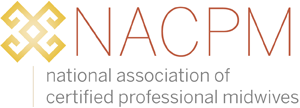The CPM Credential
National certification is a mechanism by which members of the midwifery profession exercise the right and responsibility for ensuring there are standards for the core competencies necessary for safe practice and that midwives achieve and maintain the defined competencies. National certification, like educational program accreditation, is developed and administered through private agencies.
The CPM credential was developed by the North American Registry of Midwives (NARM) in collaboration with the Midwives Alliance of North America (MANA), the Midwifery Education Accreditation Council (MEAC), and diverse stakeholders from across the United States, including consumers who later founded Citizens for Midwifery (CfM). The credential validates the knowledge, skills, and abilities vital to responsible midwifery practice and reflects and preserves the essential nature of midwifery care. The competency-based model for certification assures well-educated, skilled, and competent providers.
The requirements and process for achieving national certification as a CPM were implemented by NARM in 1994. Multiple pathways to certification were established, including graduation from an education program accredited by the Midwifery Education Accreditation Council (MEAC) or the Accreditation Commission for Midwifery Education (ACME), completion ofthe Portfolio Evaluation Process ,or holding current legal recognition to practice in the United Kingdom, legal recognition in a state previously evaluated for educational equivalency, or comparable international training. Between 1994 and 2021 more than 3,973 midwives received the CPM certification, with 2600 certifications active in 2021 .
All CPM candidates are required to demonstrate acquisition of the required knowledge and skills and to have performed competently as primary midwife under supervision. Certification is renewed every three years, and all CPMs must obtain continuing education and participate in peer review for recertification. In addition, NARM requires that each CPM have written practice guidelines, a process for informed disclosure and consent with clients, including a HIPAA privacy policy, and that the CPM participates in a one-time cultural competency course for certification or recertification. Evidence of ongoing continuing education is required to maintain the CPM credential.
Qualifications for the credential are based on a job analysis, periodic surveys of practicing midwives to determine what midwives need to know and be able to do. This process is mandated by the National Commission for Certifying Agencies (NCCA) which accredits national health credentials in the U.S., including the CPM, Certified Nurse-Midwife (CNM) and Certified Midwife (CM). NCCA is the accrediting body of the Institute for Credentialing Excellence (ICE) , formerly the National Organization for Competency Assurance (NOCA). The mission of ICE is to promote excellence in competency assurance for practitioners in all occupations and professions.
NARM’s most recent job analysis survey to identify the essential and current competencies necessary for safe and competent practice of midwifery was conducted in 2016. Participation in the job analysis survey is one important way CPMs continue to define and set standards for the profession. Approximately one-third of all CPMs who currently hold the CPM credential participated in the 2016 survey.
For more information about the CPM credential:
· Visit www.narm.org
· See NACPM’s Briefing Paper: Certification and a National Credential

